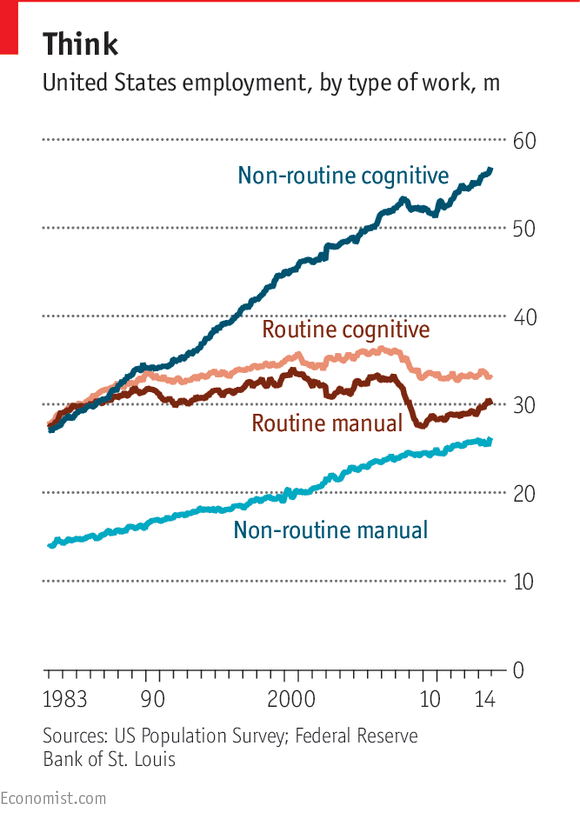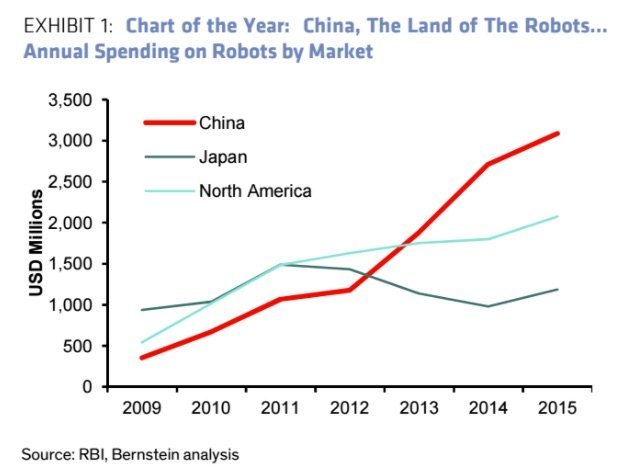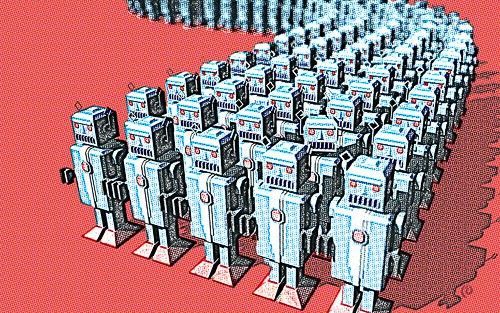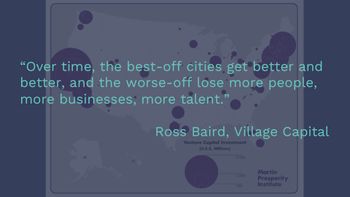There is a growing body of thought that the recent U.S. election was as much about robots and automation as anything else. That the reason many metro areas that voted for Obama in 2008 and 2012 flipped to Trump in 2016 came down to fear and anxiety. Fear and anxiety that the robots are coming to replace the few manufacturing and other middle-skilled jobs that still exist inside heartland cities and towns.
The demand for “middle–skills” jobs—those that require more education and training than a high school diploma but less than a four-year college degree—remains high, yet the lack of a properly skilled workforce is hindering the ability of American businesses to compete globally. (Source: Harvard Business School research on U.S. competitiveness)
In this blog post, we want to provide a roundup of the literature and address this fear and anxiety head on, sketching out how cities and towns can help their residents move from fear and anxiety to hope and greater optimism around the future.
- Yes the robots are coming and there is little if anything we can do about it
- Robots are probably a good thing for the economy, but only if we embrace them wholeheartedly
- How cities and towns in the U.S. can cope with this rising tide
YES, THE ROBOTS ARE COMING AND THERE IS LITTLE IF ANYTHING WE CAN DO ABOUT IT
Demand for industrial robots and algorithmic approaches to controlling fundamental business processes is skyrocketing.
In 2015, there were over 253,748 industrial robots sold an all-time high for the sector, according to a 2016 report published by the International Federation of Robotics. And – of course – the sector is not defined by robots alone but also by sales of artificial intelligence software, software bots, and deep-learning algorithms. What these technologies have in common is their ability to take over humans and – in many instances – do a better job.
One e-commerce firm – Cosabella which makes and sells women’s lingerie – eliminated its ad agency in its entirety, instead putting campaign management in the hand of an AI program called “Albert”.
Albert did a better job than humans, lifting Return on Ad Sales (ROAS) by 50% while decreasing spending on advertising by 12%. “After seeing Albert handle our paid search and social media marketing, I would never have a human do this again,” Courtney Connell said. (Source: Campaign Live, March 2017)
One of the most promising near-term applications of deep learning (DL) is in medical imaging, says John Smith, senior manager for intelligent information systems at IBM Research. To detect skin cancer, the DL algorithm learns important features related to the disease from a group of medical images and then makes predictions (i.e. detection) based on that learning. (Source: Tech Emergence, January 2017)
Even something as prosaic as farming is being transformed by technology. There’s a growing number of dairy farms where the cows are milked with minimal input from humans (Source: New York Times, April 2014).
There are many such examples.
Moshe Vardi is a Professor of Computer Science at Rice University. In 2016, he spoke at the annual meeting of the American Association for the Advancement of Science. Among his predictions – that robots could put more than half the world’s population out of a job in the next 30 years.
Moshe Vardi’s comments were picked up by Russia Today (!) under the scarey headline “Rise of the machines: Robots will replace half of global workforce”.
“I believe that society needs to confront this question before it is upon us: if machines are capable of doing almost any work humans can do, what will humans do?” — Moshe Vardi, speaking at AAAS annual meeting, 2016
Physicist Stephen Hawking and the tech billionaires Bill Gates and Elon Musk issued a similar warning last year. Hawking warned that AI “could spell the end of the human race” and Musk said it represented our “single biggest existential threat”. (Source: Guardian, 2016).
ROBOTS ARE PROBABLY A GOOD THING FOR THE ECONOMY, BUT ONLY IF WE EMBRACE THEM WHOLEHEARTEDLY
Experts are uncertain whether the rise of robotics, artificial intelligence, and software bots will replace jobs held by humans or create entirely new jobs, ones available only to those whom upskill themselves.
If history is any guide, there is every reason to be optimistic. Throughout the industrial revolution, each new wave of technology has disrupted whole industries while creating a raft of new jobs. In fact, Thomas Friedman, the respected NYT columnist and author of the bestseller Thank You for Being Late notes that in the entire history of industrialization only one industry sector has been eliminated in its entirety: makers of buggy whips, which were eliminated with the rise of the automobile (Source: Thank You for Being Late, 2017).
Likewise, the venture capitalist Marc Andreessen is optimistic, believing in what Singularity University calls the “abundance” scenario — with tools for production in the hands of everyday workers, things become cheap to make instead of buy, and the overall cost of a standard lifestyle drops precipitously. We make less money, but it costs less to live.” (Source: Gary Bolles writing on Medium, February 2017)
In the book Economics in One Lesson, the world renowned economist and another NYT writer, Henry Hazlitt noted that the advancement in technology did more to add jobs in the automotive industry than to destroy them. “In 1910, 140,000 persons were employed in the United States in the newly created automotive industry,” Hazlitt wrote. He noted that when measured every 10 years there were over 100,000 thousand jobs added. Finally, he wrote, “In 1973 it had risen to 941,000.” And according to the Bureau of Labor Statistics in 2015, the number of people who worked in the industry was over 4 million. (Source: MRC Newsbuster, January 2017).
The jobs that are most vulnerable to being eliminated in their entirety are those that are routine, where we are asking humans to act like robots.
What determines vulnerability to automation is not so much whether the work concerned is manual or white-collar but whether or not it is routine – (Source: Economist Special Report – June 2016)

Note well: it’s not just low-end/highly-manual jobs that will be going away. What makes a job susceptible to automation is the degree to which the knowledge and skills required can be routinized.
Economists don’t often agree on much but they do agree that the impact of robotics and artificial intelligence will vary by geography. The future isn’t evenly distributed and neither are highly routinized jobs.
One coping strategy for increased automation include a guaranteed national income, something that Finland is testing with 2,000 of its citizens. (Source: The Guardian, February 2017)
Another such strategy is to tax robots, in part to pay for the workers displaced. Like most protectionist policies, we think this a bad idea. The Chinese are building out expertise in robotics and artificial intelligence at a torrid pace, according to Bernstein International (Source: Business Insider, December 2016).

Robotics is a sector of the tech economy the U.S. cannot afford to let the Chinese dominate. Recently, Mark Cuban chided the Trump administration to double down on robotics (Source: CNBC, January 2017) lest we lose out on a critical source of competitive advantage. Robots are the next industrial revolution (Source: Verge, March 2017) and it’s not one America can afford to miss out on. It’s not just robotics, it has to do with the future of where manufacturing and growth in GDP will come. National wealth and economic strength will accrue to the nation that leads here. So ironically the best way to have a killer economy is to have killer robots.
We think the future is one where robots and humans will work side-by-side.
An example of the kind of collaboration between technology and people can be found in the leading edge-work undertaken by Autodesk. Autodesk focuses on applications that enable creators to be productive when designing objects that can range from products to buildings. Now they are adding AI to the tools to enable humans who use their tools to perform at the highest level, focusing more on productivity and creativity and less on engineering calculations. One of the projects highlighted is in generative design, where the computer generates hundreds of thousands of possible designs in response to a set of constraints. For example, suppose you want to design a chair that could carry the weight of a 300 lbs, weighed less than 10 lbs, and could be produced for less than $100. With generative design, a computer algorithm can iterate at almost no cost, creating a large number of potential designs, finally spitting out the one that optimized against all constraints.
The future looks like humans working side-by-side with machines, to deliver a more abundant set of products and services. To us, this feels like the highest use of a human being. Freed from the drudgery of calculations, designers can focus less on the mechanics of design and more on defining the problem, establishing criteria based on market needs, and then guiding the machine to pick out the most worthwhile solutions(s).

HOW CITIES AND TOWNS IN THE U.S. CAN COPE WITH THIS RISING TIDE
Change is hard, unsettling, and disruptive to people caught in its crosshairs. That said, there is every indication that robotics and its close cousins (AI, deep learning) will create an entirely new wave of economic opportunity, one that can lift a city or town up and turn fear and anxiety into hope and optimism for the future. See for example, the work of Alex Ross, a native of West Virginia, former Senior Advisor on Innovation to the State Department under the Obama administration, and author of the best selling book: The Industries of the Future (2016).
To prepare, we need to change how we educate our young people as well as the implicit contract between workers and the companies that hire them.
Changes in Education
Today’s educational systems encouraged students to go to college, graduate with a 4-year degree. The best and brightest continue their education on one of two tracks: a professional track (law, business, medicine) or an academic track.
But as knowledge becomes obsolete more quickly, the most important thing is not whether you have a BA, MBA, JD, or Ph.D., but the skills you have and the skills you can acquire – quickly.
Andrew Ng is VP & Chief Scientist of Baidu, the Chinese search behemoth; he also serves as adjunct professor of Computer Science at Stanford. “You need to keep learning your entire life—that’s been obvious for a long time,” says Mr Ng. “What you learn in college isn’t enough to keep you going for the next 40 years.”
David Autor is an economist at MIT, researching the impact of automation on job creation, among other things. He’d like to see the U.S. “put more emphasis on vocational and technical education, as Germany does, rather than encouraging everyone to go to university.”
Community colleges are setting up all kinds of schemes that combine vocational education with learning on the job. For example, Siemens, a German industrial giant, has launched a four-year “earn and learn” program for apprentices at its wind-turbine factory in Charlotte, North Carolina. Apprentices graduate with a degree in mechatronics from a local community college, certification from the local department of labor—and no student debt.
Changes in the implicit contract between workers and companies
Education will therefore have to be interwoven with full-time work.
People will have to continuously learn new skills to stay current. One way to do this is by people—young and old, working inside regular companies or as freelancers, blue-collar and white collar alike— to continuously upskill themselves.
Culturally, this is a bit easier to accomplish with young people versus olders workers who have been burned by efforts to retrain and reskill them for specific jobs. (Source: MIT Review, August 2016). Therefore, it makes sense to reward companies – with tax credits for example – who undertake the hard work of turning older workers into lifelong learners.
AT&T is doing pioneering work in this arena, “placing a lot more lifelong learning demands on a lot more employees”. AT&T partners with many universities to deliver skills-based training to its employees and tracks employees based upon their skill profile, to better match the needs of hiring managers inside the company with existing employees.
The company’s new implicit contract with its employees looks something like this:
We’ll provide skills training and as long as you are committed to skilling up and taking the training, we’ll have a job for you. But if you are not interested in continuous learning, you may be offered a severance package. And one more key component: while AT&T will pay for training, the employee needs to do this on his/her own time. It’s your responsibility to comport yourself as a lifelong learner; AT&T will help, but time commitment and effort is on you.
AT&T spends an astounding $250M on training per year:
“A lot is teaching people to climb poles, install services, and run retail stores, but now a lot more is in data science, software-defined networks, Web development, introduction to programming, machine learning, and the Internet of Things. … If you want to learn, we’re all in, because … it leads to more engaged employees, that equals better customer service, more loyal customers, and more shareholder value.“ — William Blase, EVP of Human Resources, AT&T
(Source: Thomas Friedman, Thank You For Being Late, 2017)
In today’s world, a large and growing percent of the workforce participates in the “gig economy” where you don’t work for a major employer like AT&T but as a freelancer. No one knows the size of the gig economy, according to Steve Hill, a former senior fellow at the New America Foundation (Source: Medium, September, 2015), but there is every indication that the gig economy is both sizeable and growing.
For workers not connected to a big company, there are companies like Udacity where you can get a nanodegree in a variety of different subjects, including robotics, deep learning, and AI.
A nanodegree is a course of study which can be completed in less than twelve months and, as you might expect, the related tuition centers on online learning materials rather than on attendance at some hallowed educational establishment. (Source: Macmillan Dictionary)
Udacity charges by the course; others, like Lynda.com, which is owned by LinkedIn, a business-networking site, charge a monthly fee for access to all courses. (It is not difficult to imagine LinkedIn comparing the skill sets of its users against those required to apply for a particular job—and then offering users the courses necessary to fill the gaps.)
As on-the-job skills come and go, having a solid foundation of basic literacy and computer skills will become even more vital.
Mark Muro of the Brookings Institute is doing an analysis of job titles in use in the U.S. and their digital content. He tells us that very few jobs require no computer skills at all. Knowing how to use Microsoft Office are table stakes for today’s workers. Tomorrow’s workers are likely to find that they also need exposure to what we here at the Maker City project call
‘modern tools of production’:
- Computer science
- CAD/CAM
- Robotics
- Electronics
- Prototyping
- Problem Solving
- Design Thinking
“Soft” skills are likewise important. In a paper published in 2013, James Heckman and Tim Kautz of America’s National Bureau of Economic Research argue for more emphasis on “character skills” such as perseverance, sociability, and curiosity, which are highly valued by employers and correlate closely with employees’ ability to adapt to new situations and acquire new skills. (Source: National Bureau of Economic Research, June 2012)
But how do you teach character? Is this really a skill? Educational experts tell us that character can be taught but we aren’t so sure about this. What we do know is that when people are exposed to the tools of Making, they are better able to showcase the results of perseverance, sociability, and curiosity in a portfolio of finished projects. The ideal portfolio is one that shows the worker is ready for the future and to work side-by-side with robots, to create the next wave of innovation.


